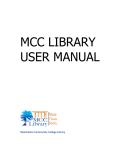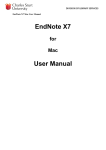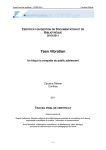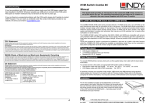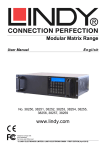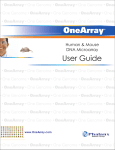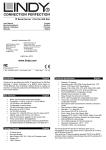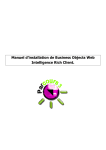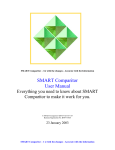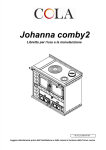Download - Open Research Online
Transcript
Open Research Online The Open University’s repository of research publications and other research outputs Can I help you? Implementing an IM service Journal Article How to cite: Hvass, Anna and Myer, Sue (2008). Can I help you? Implementing an IM service. The Electronic Library, 26(4) pp. 530–544. For guidance on citations see FAQs. c 2008 Emerald Group Publishing Limited Version: Accepted Manuscript Link(s) to article on publisher’s website: http://dx.doi.org/doi:10.1108/02640470810893774 Copyright and Moral Rights for the articles on this site are retained by the individual authors and/or other copyright owners. For more information on Open Research Online’s data policy on reuse of materials please consult the policies page. oro.open.ac.uk Can I help you? Implementing an IM service In November 2006, University of Teesside Library & Information Services (L&IS) piloted a new Instant Messaging Chat Reference Service. This article provides a case study of this experience, looking at why the service was introduced, and how successful it has been to date. The University of Teesside is a modern UK university of around 21,000 students, over half of whom are part-time, and the majority of whom originate from the local region of North East England (University of Teesside, 2008). Library facilities are provided by the Library & Information Services (L&IS) department through the Learning Resource Centre (LRC) located on campus, enhanced by a well-developed web presence. The “range, accessibility and utility of the learning resources provided to students” was identified as a feature of good practice by the Quality Assurance Agency for Higher Education in the University’s most recent institutional audit (QAA, 2004). Face to face, telephone and email enquiry services were already available from the LRC. However, as a key aspect of the L&IS department’s mission is to provide “proactive and reflective information services that are user focused” (University of Teesside, 2007), staff were keen to explore other possibilities that could be of benefit to users. Why Chat Reference The Internet and communication technologies have dissolved the walls of the libraries, and librarians can extend their reach to anywhere in the world (Di Su, 2001). Remote users are able to use computers to access information made available on library websites. Remote users are not only distance education students, who might be located hundreds or thousands of miles from the library, but also regular on-campus students, faculty and staff who may be only a few buildings away (Stanley et al, 2001). These remote users are making use of electronic journals, electronic books and databases as well as reference services such as self-help guides, tutorials for new users, and human mediated services including phone and email (Curtis, 2002). As these web-based services continue to grow, a key issue for all libraries is the identification of the best way of providing help to users. Different students have different needs and will communicate in different ways. Face-to-face Face-to-face communication in libraries relies on the students being situated in the library and so is not suitable for off-campus users. It also involves asking librarians for help. It is clear from previous research that students do not like to ask for help, and that the reference desk itself can impose a barrier to those who do go and ask a question. It can inhibit communication because it is often out in the middle of the floor where there is little privacy. Users are worried about being quiet, the interaction may be hurried due to a queue of 1 other users, and they may also be forced to stand and talk down to a librarian who is comfortably sitting (Coffman, 2003). Reference librarians sitting at a reference desk waiting for questions to come to them put the burden on the student to come to the reference desk. “As the student approaches the reference desk the librarian often appears too busy typing on the keyboard or reading to be considered approachable by the student” (Archer, 1999, p. 42). Many students are shy or do not want to admit that they need help, forcing them to approach the reference desk only increases the students anxiety levels. Phone Reference Phone reference offers interactive and immediate communication, and is very good for ready reference questions. However, the librarian cannot see the user’s computer screen or use non-verbal indicators to assess the person’s understanding, satisfaction or skill and comfort level with technology (Stanley et al, 2001). For the users, phone calls can be expensive, especially from long-distance and during the working day. Remote dial-up users may have to disconnect from their Internet connection in order to get help (Levy, 2002). Long and complicated instructions can be difficult to note down by phone (Sen-Roy, 2004). Email Reference Email reference offers benefits to users who are shy and uneasy about asking questions in person, and to distance and remote students (Sheldrick et al, 2002). Librarians report that it takes longer to answer a user’s query when it must be text based, than it does to respond to a similar query orally in a traditional reference desk setting (Ryan, 1996). However, Bristow (1992, quoted in Gray 2000) reports that with email the librarian has time to think the question through completely, and consult with colleagues if necessary. This is backed up by Johnston & Grusin (1995, quoted in Gray 2000). Email reference allows a more complete answer to questions than may be provided at a traditional reference or information desk. Using web forms can be useful because they are structured in such a way as to guide users in asking their question, helping them to frame their questions as well as gathering important information which can be used for service evaluation (Berube, 2003). However, email is not instant communication; there can be an unknown delay between sending the email and receiving a reply, and this can make it difficult when conducting a reference interview (Coffman, 2003). 2 Chat Reference Chat reference is “live, online reference, where the user asks a question online and carries out a conversation with the librarian” (Katz, 2003, p.50). It allows remote support to have “more sophistication and immediacy, and maybe even with a more personal touch” (Breeding, 2001, p.12). For users with broadband connections, chat reference is free. Increasing numbers of researchers are using the library from remote locations and the need for online reference is increasing (Coffman, 2003). Chat reference has more in common with face-to-face reference than with email reference and search engine use. “It combines the personalised service of the traditional reference transaction with the remote access capability and anonymity of a search engine” (Desai, 2003, p.20). Online reference that is comparable to face-to-face reference requires realtime interactivity, high social presence and media richness. Exchanges in chat are often rapid and informal and therefore are more like spoken language (Hartley, 2001). It is good for quick exchanges but not so good for in depth reference questions, which is why it is being used as well as the other services provided by libraries and will not replace them (Desai, 2003). The librarians staffing the service are encouraged to be aware of this and if an enquiry could be dealt with better in another way to suggest this to the user. Chat reference can be more straightforward than email, it is easier for a librarian to conduct a reference interview in real-time with the user sitting on the other end of the line, because they can clarify questions and receive instant feedback from the user (Levy, 2002). The service allows remote or shy students to ask questions online, and get instant and anonymous support. Users in cyberspace may prefer anonymity to face-to-face communication, and feel free of the captive nature inherent sometimes in the personal interview controlled by the librarian (Koyama, 1998). When Internet users are anonymous they feel freer and less constrained (Kiesler et al, 1984, quoted in Dietz-Uhler et al, 2002), because of this they may be more likely to ask for help when it is needed. Library staff can refer the user to the online catalogue and indexes, escort users through complex searches, provide bibliographic instruction, and provide the required information in the form of web pages, electronic journal articles and online reference sources (Sheldrick et al, 2002). URLs can be pasted and sent online. It is also possible to create session transcripts which can be emailed to the user (Eichler et al, 2000), which means that they do not have to take notes as the chat session takes place. This is difficult with phone conversations (Curtis, 2002). Chat Reference involves a lot of typing both for the user and the librarian. This may be seen as an advantage for users who feel more comfortable with their written skills than their verbal ones. However, for users with poor typing skills, this can be time consuming and cause anxiety (Nilsen, 2004; 3 Warkentin, 1997; Berge, 1995). Because of this, individuals may purposefully avoid typing statements that would be naturally stated in a telephone or faceto-face conversation (Graetz et al, 1998). However, there are advantages to chat communication in that compared to spoken statements written ones are edited and composed more carefully and are received more quickly, this “increasing potentially the quantity and quality of information contributed during an electronic chat discussion” (Graetz et al, 1998, p. 718). Previous literature shows that when Telephone Reference was first discussed it was debated to the same extent as Chat Reference is today (Schmidt & Stephens, 2005). Supplier-provided web chatting software Online chat is provided as part of virtual reference management services such as QuestionPoint from OCLC PICA. These services have been in existence for a number of years. “Web chatting software is rapidly becoming the tool of choice for delivering real-time reference services” (Curtis, 2002, p.92). This software is mainly web based which means that the user only has to click on the icon on the library web page to make the program run. Once the user starts the chat, they will be asked to fill in some details; what they are asked for will depend on the service. Some will only ask for an email address and a name, but others require passwords to log in: this is used to restrict the service to students at a particular library. However, web chatting software can be expensive. It can be slow and formal in that the students have to enter details before they are connected to a librarian (Houghton et al, 2005). Some US libraries found that more complex and expensive Chat Reference software did not always result in more chats (Ward, 2006). Instant Messaging Another option is Instant Messaging (IM) offered on the web by providers such as AIM, MSN, Yahoo, and Google Chat. More and more libraries are using Instant Messaging (IM) as a way to chat with their users especially in the US (Ciocco et al, 2007). According to the Library Success Wiki (2008) at the time of writing, there are 130 library services in the US using IM, but only 5 in the whole of Europe. Instant Messaging is faster in terms of interaction between the librarian and the user than vendor-based chat, and it is free. In terms of training, it takes less time to train staff, as they are either already aware of IM or can learn to use it quickly because it is simple and straightforward (Ward, 2006; Ward et al, 2006). IM is familiar to users; it encourages repeat use through the buddy list, and it is perceived as friendly and informal, and has the advantage of an installed user base (Fergusson et al, 2005; Houghton et al, 2005). 4 There are lots of different IM clients and almost as many different IM providers. None of these networks talk to each other; users can only talk to others on the same network as themselves. However, aggregators such as Meebo exist which allow users to have accounts with all or most IM providers through one interface. Although traditionally IM use in the UK has not been as big as in the US, the trends show that usage is increasing. As of October 2003, it was found that the most time spent online in the UK is spent on the use of Messenger applications (Mintel, 2004). According to an IT consultancy company quoted in the Guardian, 90% of business email users will have IM accounts by 2010 (Mathieson, 2006). The number of users of Meebo is around 3.5 million, 30% of those are based in the United States with 70% being International, China and Britain are in close competition for the fourth largest number of users (Auchard, 2007). This underestimates the number of users of Meebo as you do not actually have to register with them to be able to use the service. Therefore, a long with the vast audience for Instant Messaging, there is also a growing number of users of Meebo. Staffing: Who and where? The literature recommends that staff should volunteer to be involved with chat reference services (Coffman, 2003). They should be selected on their ability, interest, availability, enthusiasm, good customer service skills, comfort with technology and electronic resources. As well as basic computer techniques, they need to have knowledge of electronic resources and searching skills, reference interview skills and online communication skills (Luo, 2007). It is recommended that the chat service is offered away from the main service points. Chat interaction can be misinterpreted by waiting face-to-face users as ignoring them. It also can take a fairly high degree of concentration to carry out chat reference, and an information desk can be a distracting place. For example, the software uses an audible cue to alert staff to waiting users (Ohiolink, 2005). Moreover, staff sometimes need to leave the desk to help face-to-face users, which leaves the chat reference service without support. Implementation After consideration of all the issues, the University of Teesside decided to pilot an IM chat reference service using the aggregator Meebo. Meebo was selected for its wide coverage of networks, and the fact that it is web-based, which means that there is no downloading for either staff or students. This meant that L&IS could have accounts with AIM, Yahoo, MSN, Google Chat, ICQ and Jabber accessing them all through one sign on with Meebo. Volunteers to answer IM queries were sought from members of the Academic Information Team, professional staff who already deal with complex information enquiries either face-to-face on information desks, or via email. 5 Each member of staff who expressed an interest was set up with MSN and Meebo accounts. Once everyone had an account they were encouraged to chat to each other in order to practise. There was also training on chat etiquette, online communication and procedures. None of the librarians had used IM before, and so it was important to have a period of adjustment learning about the Meebo software, and going through IM conventions, for example not using capital letters, acronyms and emoticons. The main areas for adjustment were in taking turns to speak, and learning how much space to leave between comments. In fact, the staff adapted very quickly to chatting with each other. Going Live Once staff had become confident chatting with their colleagues, the decision was made to launch the service. We wished to staff the service away from the existing information desks, but there was no extra funding available for the pilot, so the chat service had to fit in with existing rotas and other responsibilities. Due to these limitations, the chat service could only be offered for four hours a day, Monday to Friday, with each librarian on the ‘desk’ for two hours at a time. A generic username and password was set up, so that the service would be as seamless as possible to users. Accounts were then set up with all of the Instant Messaging providers mentioned above, and an overall account was set up with Meebo, all with the username of teesunilibrarian. There was some discussion around the username; we wanted it to be meaningful to users, but we were limited by the number and type of characters that could be included. A webpage was set up (http://lis.tees.ac.uk/chat) which gives details about how to chat with a librarian and the hours that the service is available. This was promoted from the front page of the L&IS web page. The service was marketed with the heading ‘Chat with us’, as we were concerned that neither the terms ‘Chat Reference’ nor ‘IM’ would be understood by all users. We have however made use of the logos of the main IM providers in our promotional images and web pages, to attract existing users of particular IM providers to the chat service. Staff on the rota initially expressed satisfaction with the process of using IM, but would like to have received more queries. In order to increase usage, a ‘Meebo me’ widget was included on the web site from January 2007. This enables students to contact us without having to have an IM account, and so facilitates totally anonymous communication. Then in January 2008, the Meebo me widget was embedded in Blackboard, the University’s VLE. This offers students another means of contacting us without going through the L&IS web page. Unfortunately from Meebo it is not possible to see if enquiries are arriving via the widget on the L&IS site or from Blackboard. 6 How does the student use it? Students can use Instant Messaging software that they are already familiar with, whether from a version that has been downloaded on to their own computer, for example at home, or from the web-based client. They can add L&IS to their ‘buddy’ list, so that they can contact us directly without needing to go outside of their IM environment. Alternatively, if they do not already have an IM account, they can choose to register and log into an account with Meebo or to use the Meebo me widget. If they use the Meebo me widget, they just need to type into a query box on the L&IS web site; there is no need for them to login or tell us who they are. Outside of the service hours, users with our IM username in their buddy list will see that we are offline. The Meebo me widget on the website also indicates that ‘teesunilibrarian’ is offline. If any messages are sent when we are offline they will pop up when we next log in. Evaluation Meebo does not include statistics, so usage of the service has been evaluated in a couple of ways. We registered the introductory chat page with Google Analytics, along with our home page address to see how many users were accessing the introductory chat page, and how that compared with the home page of the site. The results indicated that only a small minority of users chose to click on the chat page. Between November 2006 and the end of June 2007, there were 908,234 visits to the L&IS home page, but only 2,394 visits to the chat page. However, since students could chat with us without coming to the web site, and other students may view the chat page without using the IM service to communicate with us, this does not give us an accurate usage figure. More significantly, each librarian on the rota records each chat in a shared file. This record includes any comments or problems and a copy of the transcript stripped of personal information. This shared file not only gives us data on how busy the service has been, and what questions have been asked, it also means that the transcripts are available as a training tool and as a good record to look back on. 7 Analysis of chats 194 chat reference queries were recorded up to the end of June 2007. Although the number received has not been large, they show a steady increase over the academic year. Breakdown by month: Month No of Enquiries Nov 2006 9 Dec 2006 11 Jan 2007 18 Feb 2007 18 March 2007 29 April 2007 31 May 2007 50 June 2007 28 The chat service has only been available for four hours per day, Monday to Friday. The popularity of the different hours is shown below, for enquiries from November 2006 to the end of June 2007: Time 11am-11.59am 12pm-12.59pm 1pm-1.59pm 2pm-2.59pm No of Enquiries 80* 29 38 47 *11am-11.59am figure includes 20 enquiries which were waiting for staff as they logged into the service. One of the drawbacks of Meebo is that it does not give a time to an enquiry when it is made, if the recipient is not online at that time. The length of queries has varied, from less than a minute to over an hour. There have been a wide range of queries, covering all aspects of the LRC’s services. As well as many straightforward queries regarding passwords and renewing items, there have been more complex requests for assistance with literature searching, and with referencing. Librarian impressions Initially the librarians who staff the chat reference service had to adjust to the new skill of IM conversations. Once they had become accustomed to communicating in this way, they have been positive about dealing with queries from students. “To start with, I felt like I had to answer everything straightaway which was quite nerve-wracking. After I’d got used to saying something like “please bear 8 with me, I’ll just find out for you” it took the pressure off and now I like speaking to people in this way” “You do get quite a good sense of satisfaction when you see ‘thank you’ written down” “You get feedback when you’ve solved their enquiry which you sometimes don’t get with email, though it can be quite pressurised”. “It’s made us work together as a team in the office to answer queries if someone’s stuck” The nature of communicating in short snippets also meant a change from the previous experience of composing long email messages. One colleague who had tried to answer a query with paragraphs had found the experience frustrating: “This would have been much quicker and easier for the client and me if we’d just talked on the phone instead” [14:11](caller): i am a second year student nurse, as one of my modules is appraising evidence ,for my assignment i have to develop a focused question and then a structured search on Cinhal [14:11] (caller): any tips? [14:15] teesunilibrarian: Well, we have factsheets available on all the databases that we currently subscribe to, these are available in paper format in the building and online. You will see a link to factsheets and tutorials on the page that also shows you how to access the services off campus. In addition we have factsheets on searching and I will just check the numbers and titles of these and get back to you. In addition I would suggest always starting with fairly general terms for what you are looking for and then narrowing them to refine the result, also noting which terms you have used in combination so that you can vary them and think of alternative terms to try. I hope this is helpful, I'll check the factsheet numbers for you and get back to you in a few minutes. [14:16] (caller): aww thankyou so much! [14:23] teesunilibrarian: Hello again, The factsheet that would be most helpful for you would be number 10 Devising a search Strategy. We also have one for the British Nursing Index No60 and the CINAHL and Medline factsheet at number 55. All these can be accessed from the factsheet link under the Improve your skills header on the library home page. If you need more help let us know. If you get really stuck we can arrange to go through it with you briefly when you are in the building. Has this been helpful? [14:23] (caller): yea great thanku very much [14:24] teesunilibrarian: A pleasure, If there is anything else we can help you with, let us know. Good luck with the searching. [14:24] (caller): thankyou The occasional ‘nuisance’ chat has been difficult for staff. One member of staff commented: “I realise I’m a bit paranoid but I get a bit freaked by this” after the following conversation: [14:23] (caller):you a he or a she? [14:23] teesunilibrarian: hello, can I help you [14:24] (caller): yeah, jsut wondering if you were male or female... [14:25] teesunilibrarian: I'm here to help with L&IS queries - it is not necessary for you to know my gender [14:25] (caller): ok. [14:26] (caller):im just bored. [14:26] (caller):good bye? have a nice day. [14:26] teesunilibrarian: good bye 9 When the service began, staff covered two hour shifts. However, they found that this felt like a long time to remain at their desks, even though they could continue with other work, especially if no queries were received during their shift. The slots were therefore changed to one hour. The shorter shifts have been much more popular. Student impressions The students who have used the service had been extremely appreciative, with many returning to ask other questions: “for now im very thakfull for you great information , hope for you nice day and enjoyable work day” “thanks ure wonderful” However, the service has as yet not been noticed by the majority of University of Teesside students. In the 2007 LRC Spring Survey, students were asked if they knew about the IM chat service. Of the 17351 students who completed the survey, only 15% were already aware, with only 15% of those actually having used the service already. However, of the 85% who did not know about the service, 59% said they would use it in the future, 33% were not sure and only 8% said that they would not use it. There is evidence that students have added us to their buddy lists and that these students are able to see from a glance if there is a librarian online, and are one click away from asking questions. Advantages The chat service has enabled us to communicate easily with students who might find it difficult to use other methods of communication. It has been particularly useful for students based overseas, likely to be a growing part of the University of Teesside’s student population. It has allowed students to report anonymously where they might have felt wary of approaching a member of staff. For example, 14:01] (caller): who do we speak to about people playing music in the library [14:03] teesunilibrarian: Hi. Are you in the LRC and someone is disturbing you with music on headphones? [14:05] teesunilibrarian: if this is the case, either speak to one of the ICT Advisers (in green shirts) or speak to the person on the nformation desk, who will go and ask the person to stop (or turn the sound down). [14:05] (caller): No it is someone with speakers on [14:06] teesunilibrarian: Which floor are you on? And which side? [14:06] (caller): I am on the ground floor and not entirely sure where it is coming from [14:06] teesunilibrarian: I’ll ask someone from the Enquiry desk to come over and have a look and listen and deal with the problem. I’m ringing them now [14:07] (caller): thank you very much The service has also led to contact from other university libraries interested in the Teesside experience, from elsewhere in the UK, the US and Australia. 10 Issues The greatest issue that has been faced is the relatively small number of queries. We have not marketed the service extensively beyond the L&IS web site and Blackboard (the University’s VLE). The results from the LRC student survey indicated that more extensive marketing would increase usage of the service. It is hoped that awareness will now have been raised by including a question about the chat service in the student survey. Moreover, the service will be promoted in literature given out in inductions and talks to new students, which did not occur in 2006 as the service did not begin until November. However, it may be that it is the limited hours when the service is available that has restricted the number of queries to date. L&IS staff are still considering ways in which the hours of the service could be extended. When the service was set up at Teesside, it was not known whether students would wish to communicate with L&IS staff at all, so the decision was made not to be too restrictive about the nature of enquiries. Overall, this policy has been successful as it has led to enquiries about a wide range of library services, but it has also caused some difficulties. In particular, one prospective student from Nigeria made 21 enquiries in May and June 2007. The majority of these enquiries were concerned with contacting the international office, so were not related to library resources. The nature of the rota meant that librarians were not immediately aware that he had been making contact quite so frequently. At times, it appeared that he was making an inappropriate use of the service, but looking back at the transcript of his first conversation with a member of L&IS staff (see below), it can be seen that he was actually encouraged to ask questions that went beyond the library service: 11:01] (caller): hello tees [11:02] teesunilibrarian: Hello, how can I help you? [11:02] (caller): am sorry dont rrreally know if i can aask you any questioon here [11:03] (caller): or its all about the library?? [11:03] teesunilibrarian: Well its intended as a service to help you with our services and resources but we do get asked other things too. [11:04] (caller): oh ok thats good to hear This example points to the need for staff to be clear about what queries the service is intended to cover. The combination of staff that are keen to be helpful and the informal nature of the conversations can otherwise lead to misunderstandings. However, L&IS staff are becoming increasingly skilled at responding politely to inappropriate queries. For example: [12:43](caller): One day I would like to have a talk to you [12:43] (caller): Would it be possible [12:43] teesunilibrarian: are you a student at the university [12:45] ](caller): no I am working in a BPo compnay [12:46] teesunilibrarian: then I'm afraid I can only chat to you if you have a library query [12:46] ](caller): Are there any restraints 11 [12:47] teesunilibrarian: obviously we have to prioritise our students [12:48] ](caller): ok Great [12:48] ](caller): I will be asking queries regarding library only [12:48] ](caller): anyways thanks Overall, we have been extremely satisfied with the technical aspects of Meebo; it is a free, easy to use product. As the service is reliant on external software, there have occasionally been a few problems with the IM provision, although this has been limited. At the end of each shift, the librarian on duty has to sign off before the next one can sign in. This caused some adjustment to begin with, but staff are now accustomed to ensuring that this transfer is as quick and as smooth as possible. The software does not give us some of the functionality of supplier-based chat. For example, statistics have to be collected and transcripts saved manually. There is no possibility for co-browsing which would have been helpful for some enquiries. As librarians, we would like to be able to find out more about who the users are and where they are based. However, these disadvantages are outweighed by the ease of use both for students and L&IS staff. There have been some issues with the Meebo me widget on the web site. This enables students to contact us without logging in. The widget has been popular with users – after it was introduced, 60% of the next 60 queries came via that route. However, users who are communicating via the widget do not have the same on-screen cues to indicate that staff are typing a response to them, and perhaps as a consequence, more conversations have ended abruptly without an indication from the student that their query was answered to their satisfaction. In some cases, this may have simply been because the Meebo widget users were less familiar with IM, and so less aware of the etiquette for closing conversations. There have been a small number of abusive messages, the majority of which have come via the widget. 12 Future What is the future of Instant Messaging in libraries? It is clear from our student survey results, that it is a service that is not widely known about. However over half of those who said that they were unaware of the service, mentioned that they would be willing to use it in the future. Our next step is to evaluate and to market the service further. The literature at the moment is full of discussions of Web 2.0, Library 2.0, and the issue of how we keep up to date with what users want? As librarians we need to embrace change and use new developments to our advantage so that we are able to offer better reference services to those students who are overwhelmed by our online resources. We need to be flexible, and willing to accept that all solutions are temporary, and may quickly be superseded by better means of responding to queries. We need to strike a balance between innovation and ensuring that students remain familiar and comfortable with our services so that they continue to find them easy to use. The use of VoIP and social networking may well be the next step in providing services that encourage communication in ways with which students are comfortable (Lukasiewicz, 2007). More and more computers are being fitted with microphones and speakers, and this way of communicating is becoming more and more popular. It removes the cost of phone calls and allows phone conversations from where the user is working. An ideal reference enquiry will involve both VoIP and chat, where we can have a conversation but also be able to send URLs and files over the internet instantly. Another important development is a single interface that provides reference by email, chat, VoIP, SMS, and Video conference so that all possible tools are brought together. These Request Management Systems such as Altarama’s RefTracker are becoming more popular with libraries (Forster, 2006). It is increasingly important that there is continual analysis and research into new technologies and innovations that may change the way that reference services are conducted in the future. The functionality of Meebo is adequate for the service we are running at the moment – its simplicity being its biggest asset. However, it is possible with further marketing the number of users would increase to the point where further functionality would be useful. For example, to be able to have more than one librarian logged in under the same screen name, as well as to have automatic statistics logging and transcripts archiving. Instant messaging at the end of the day, like the phone and email is another way for users to get in touch with us. Anything that increases communication should always be encouraged. I hope to see IM reference quickly becoming an everyday part of our service, in the same way that phone reference did. 13 Conclusion We were able to set up a really simple service, without the need for the purchase of hardware or software. We now have another quick and easy way for our students to communicate with us. Therefore, we can meet and help users, where they are, in their own comfort zone, with their own tools, when they need help the most, in the simplest way possible. We have had some issues fitting this service into our existing range of help services, and we are concerned about the relatively small number of queries, although usage of the service is growing. But these are all problems from a librarian’s point of view; the users of the service have been delighted with it. We would certainly recommend that other libraries should test it out. 14 Bibliography Archer, S.B. & Cast, M. (1999) “Going Where the Questions Are: Using Media to maintain Personalised Contact in Reference Service in Medium Sized Academic Libraries”, Reference Librarian, Vol 66, pp. 39-50. Auchard, E (2007) Instant Message Unifier Meebo Secures Fresh Funding, [ONLINE] Available http://www.itpro.co.uk Berge, Z. (1995) “Computer Mediated Communication and the Online Classroom: Overview and Perspectives”, Computer Mediated Communication Magazine, Vol 2 No 2, p. 39. Breeding, M. (2001) “Providing Virtual Reference Services”, Information Today, Vol 18 No 4, pp. 42-43 Ciocco, R; & Huff, A (2007) “Mission IM-Possible”, Computers in Libraries, Vol 27 No 1, pp. 26-31 Coffman, S. (2003) Going Live: Starting and Running a Virtual Reference Service, American Library Association, USA. Curtis, D. (2002) Attracting, Educating, and Serving Remote Users Through the Web: A Howto-Do-It Manual for Librarians, Neal-Schuman, New York. Desai, C.M. (2003) “Instant messaging reference: how does it compare?” The Electronic Library, Vol 21 No 1, pp. 21-30. Di Su (2001) Evolution in Reference and Information Services: The Impact of the Internet, The Hawthorn Information Press, New York. Forster, S. (2006, May). “Using instant messaging for online reference service”, Australian Library Journal, 55(2), 147-158. Graetz, K.A. et al (1998) “Information Sharing in Face-to-Face, Teleconferencing, and Electronic Chat Groups”, Small Group Research, Vol 29 No 6, pp. 714-743. Hartley, P. (2001) Interpersonal Communication, 2 nd Ed, Routledge, London. Houghton, S. & Schmidt, A. (2005) “Web Based Chat VS Instant Messaging: Who Wins?” Online, Vol 29 No 4, pp. 26-30. Katz, B. (2003) Digital Reference Services, Haworth Information Press, New York. Keisler, S., Siegel, J. & McGuire,T.W. (1984) “Social Psychological Aspects of Computer Mediated Communication”, American Psychologist, Vol 39, pp. 1123-1134, Quoted in, DietzUhler, B & Bishop-Clark, C (2002) “The Psychology of Computer-Mediated Communication: Four Classroom Activities”, Psychology Learning and Teaching, Vol 2 No 1, pp. 25-31. Koyama, J.T. (1998) “http://digiref.scenarios.issue”, Reference and User Services Quarterly, Vol 38 No 1, pp. 51-53. Levy, D. (2002) Virtual Chat Reference Services, [ONLINE] Available http://www.slais.ubc.ca/courses/libr500/01-02-wt2/www/D_Levy/text.htm 15 Library Success Wiki (2008) Libraries using IM reference. Available http://www.libsuccess.org/index.php?title=Libraries_Using_IM_Reference Lukasiewicz, A (2007) "Exploring the Role of Digital Academic Libraries: Changing Student Needs Demand Innovative Service Approach", Library Review Vol 56 No 9, pp. 821-827. Luo, L. (2007) “Chat reference competencies: identification from a literature review and librarian interviews” Reference Services Review, Vol 35 No 2, pp. 195-209. Mathieson, S. A. (2006) “Web 2.0: just kids' stuff?” The Guardian, The (London, England) May 26. Available http://technology.guardian.co.uk/businesssense/story/0,,1782886,00.html Nilsen, K. (2004) “The Library Visit Study: User Experiences at the Virtual Reference Desk”, Information Research, Vol 9 No 2. Available http://informationr.net/ir/9-2/paper171.html Ohiolink (2005) Chat Reference Service Manual, Available http://www.cl.utopedo.edu/userhomes/wlee/chatmanual.html, Quality Assurance Agency for Higher Education (2004) University of Teesside Institutional Audit. Available http://www.qaahe.org.uk/reviews/reports/institutional/Teesside04/findings.asp Schmidt, A & Stephens M (2005) "IM Me", Library Journal, April. Sheldrick, R.C.; Nilsen, K. & Dewdney, P. (2002) Conducting the Reference Interview: A How to do it Manual for Librarians, Facet Publishing, London,. Stanley, D. & Lyandres, N. (2001) “Reference Assistance to Remote Users”, Reference Librarian, Vol 73, pp. 243-252. University of Teesside (2008) University Statistics. Available http://www.tees.ac.uk/sections/about/FactsAndFigures.cfm University of Teesside Library & Information Services (2007) Mission, Values and Aims. Available: http://lis.tees.ac.uk/factsheets/fs0.pdf Ward, D. & Kern, M.K. (2006) “Combining IM and Vendor-based Chat: A Report from the Frontlines of an Integrated Service”, Portal: Libraries and the Academy, Vol 6 No 4, pp. 417429. Ward, D. (2006)”Instant Messaging and Chat Reference”, Internet Reference Services Quarterly, Vol 11No1, pp.103-106. Warkentin, M.E. (1997) Virtual Team Versus Face-to-Face Teams: An Exploratory of a Webbased Conference System, [ONLINE] Available http://www.findarticles.com/p/articlea/mi_qa3713/is_199710/ai-n8758806/print. 16



















